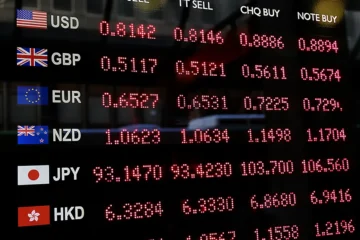US
On Wednesday, following the FED committee’s meeting, Jerome Powell announced that the US central bank is leaving interest rates unchanged by saying that “we don’t see a strong case for moving (interest rates) in either direction”. Although the United States showed an impressive GDP growth in the first quarter of 2019, investors were expecting a slightly dovish view from FED’s chairman because of the low inflation figures.
The US stock market largely remained to its record-high levels during the week ended February 18. The S&P500 moved from 2,940.58 to 2,945.64 (+0.19%), the Nasdaq went up by 0.20% from 8,147.65 to 8,164.00 and the Dow Jones closed down at 26,504.85 with a -0.21% change from Monday’s open at 26,559.87.
In spite of the low weekly changes, the three main indexes showed a similar volatile path, dropping the day after the Federal Reserve decision and quickly recovering on the last day of the week.
The yield on the US 10y T-Note closed up 2.43% moving from a Monday opening at 2.47% to its Friday value of 2.53%. Such an upward movement was due to the lowering probabilities of a rate cut over the course of the year.
The Dollar depreciated against major currencies as the Dollar Index fell from a value of 98.03 on Monday to a value of 97.48 on Friday (-0.56% weekly change).
Next week the US Trade Balance in March and data on jobless claims will be released.
UK
Similar to last week, the FTSE 100 was down again by -0.6% to 7380.64, nonetheless, one of the biggest winners being the British multinational medical equipment manufacturing company Smith & Nephew at a weekly rise of +5.1% therein a +3.2% jump on Thursday’s earnings release. Biggest loser turned out to be easyJet, losing 5.0% on Thursday and Friday alone. In accordance with equity markets, the 10 year Gilt climbed back to 1.22 from 1.14 at market open on Monday and the Sterling enjoyed a late rally of +1% just on Friday totalling +1.9% appreciation for the week, closing at 1.3868 against the greenback.
As mentioned in last week’s market recap, the Bank of England released its rate decision and the inflation report on Thursday. The report states, since uncertainties over Brexit have increased, UK economic growth has slowed, and inflation has fallen back close to the 2% target. Hence the BoE has kept interest rates unchanged at 0.75% for now.
Besides earnings release and inflation, this week’s market movements were driven by further April’s economic indicators for the UK, where one of the higher impact reports indicating the UK manufacturing activity, the IHS Markit manufacturing purchasing managers’ index, showed a clear slowing for the month. According to the report, reason is the easing of built up stock of companies, following the extension of the Brexit deadline. The index dropped to 53.1 in April, down from the 13-months high of 55.1 in the previous month, although the decline was inline with expectations. The previous Brexit deadline had manufactures anticipating a disruption in the supply of goods and raw materials, and hence increasing their output. This activity now reduced as the deadline was shifted from March to the end of October.
Europe
The key takeaways for the shortened trading week are that despite the Eurozone managing to moderately surpass expectations in monthly and quarterly reports (yet negative), in particular with Italy exiting technical recession, the earnings season left European equity markets rather flat.
Starting with the economic sentiment indicator, released on Monday this week, it showed a considerable downturn for both, the European Union and Eurozone in April. This stems especially from lower confidence in industry, retail trade, and partly in construction and consumers, according to the European Commission. A closer look at the consumer confidence indicator (CCI) reveals households’ more pessimistic expectations about their future financial situation and, in particular, the general economic situation. By the numbers, in the Eurozone the CCI decreased to -7.90 index points in April, down from the previous month’s figure of -7.20, while for the EU it was confirmed at -7.70 in April, down 0.60 points compared to March.
On the flip side, the seasonally adjusted GDP showed an increase of 0.4% in the Eurozone and of 0.5% in the EU for the first Quarter of 2019according to the GDP preliminary flash estimate published on Tuesday.
An unexpected driver of this development was Italy which still lags behind the Eurozone as a whole, due to sluggish domestic demand. However, Italy’s GDP rose by 0.2% in the first quarter of 2019, exceeding expectations of +0.1%, and exiting its third technical recession in a decade, according to data published on Tuesday. The statistical office further stated that the expansion is led by net exports, while the domestic market is lagging behind.
With respect to markets, with an average rise in earnings of 3% compared to the previous year’s first quarter, a total of 53% of Stoxx 600 companies have beaten estimates after markets closing Friday night. Still, the Pan-EuroStoxx 600 closed almost flat for the week at 390.37. Other major European Indexes are with no surprises pretty much inline, the DAX was up just +0.6% to 12,412.75 and CAC 40 was down by 0.4% to 5,548.84. Contrary to positive news on Italy’s economic expansion, the FTSE MIB lost its +1% Monday-to-Tuesday gain throug the week, leaving it also down -0.3% at 21,763.48.
RoW
This past week, major Asian stock markets suffered from national holiday closures with the exception of the Hong Kong stock exchange. The Shanghai Stock Exchange closed earlier on Tuesday; the SSE Composite Index was at 3,078.34 with an almost null 2-days change. In India, the SENSEX Index moved from 38.952 to 38.938 after a quite volatile week with a peak at 39,166 reached on Friday; Hong Kong’s Hang Seng Index was by far the Asian best performer moving from its Monday opening at 29,646.07 to its Friday closing at 30,081.55 (+1.47% weekly change) while stock markets were closed in Japan for the whole week.
In Russia, the MOEX Index increased from 2,568.61 to 2,580.95 during a highly volatile week which showed a low value of 2,553.54 on Tuesday. Moreover, the Ruble depreciated against the Dollar as the USDRUB exchange rate moved from 64.69 to 65.08 with a +0.60% weekly change.
Oil prices are down this week due to better-than-expected US oil inventories data released on Wednesday. The Brent moved from $71.60 to $70.85 (-1,05%) and the WTI was down by 1,73%.
Next week the minutes of Bank of Japan’s last meeting will be released. Also, China will disclose its April Trade Balance with the US and its Consumer Price Index.



0 Comments